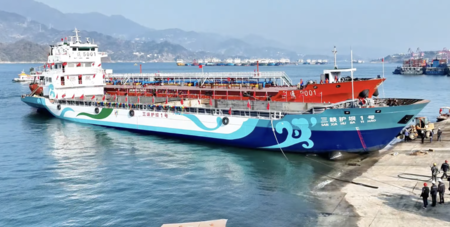The world has engaged in the electrification of the transport network. It is a vital part of the emission reduction plan, and although cars play an important role, there is a sector that cannot be overlooked: that of ships. The majority of world trade moves in the oceans and we have been watching projects such as the Yara Birkeland or the Ferris ship to connect ports. And that maritime electrification is critical in China.
Discarking is a fundamental part of China’s short -term strategies and, although we have been seeing results for years, it is not enough. Being the country that leads the production of batteries and electrification of cars, assaulting the seas was the next logical step. They have several projects underway, but curiously one of the most striking, for their versatility, is that of the first fully electric cleaning ship.
It is a ship owned by China Three Gorges Corporation, the company that manages the imposing prey of the three throats that also has departments for the research of renewable technologies. This ship has a double mission: clean the floating waste of the rivers and, in the flood seasons, be used as a transport ship along the Yangsé River.
Its main characteristics are as follows:
- It has 82 meters long.
- 18 km/Hy 4,000 kWh batteries.
- It has an autonomy of 150 kilometers per load.
- A savings of 253.4 tons of diesel are expected per year.
- Also a reduction of 842.4 tons of annual CO₂ emissions, 25,300 tons throughout its useful life.

CTG estimates a useful life of 20 years and, apart from emission savings, they expect the ship to allow Save 20 million annual yuan(about 2.80 million dollars) in fuel. After being thrown in December last year and a first inaugural trip, he is ready to sail fulfilling his mission.
China climbs into the electrification ship, literally
Beyond this cleaning ship, China’s intention is that transport diversification begin to bear fruit in the short term. Within these actions, and apart from the incentives for shipyards and companies that adopt these technologies, an update of recharge infrastructure in strategic ports has begun to be performed.
Because there are two factors that come into play: on the one hand, the batteries had to allow dilated autonomies to Maximize the operating time in the sea. On the other, the ports should have the ability to quickly recharge those batteries while maintenance work is performed on the ship itself.
Fruit of that strategy, we have projects such as two containers that are estimated to enter service at some time next year. These are two 100% electric ships of about 130 meters in length that has the capacity to transport from 10,000 to 13,000 tons, while having autonomies of about 500 kilometers to make routes between the port roads of the country.
Improving communication between its main ports is another of the projects in which China has embarked, and these container companies will have ten batteries with a total power of 1,900 kW.

Yujian 77
But they are not only developing container. A few weeks ago the service entered Yujian 77, the first totally electric passenger ship in the country that, with 49 meters in length, has a capacity for 358 passengers and the objective of performing tourist routes in coastal areas.
And they are also developing the Future, an advanced ship focused on the oceanic research that has as a mission Study the oceans and perform “green technology” tests. It has a length of 110.8 meters, capacity for 80 crew and what attracts the most attention is the ability to operate for 60 days in a row, being fully electric.
But, although that entrance of China through the big door in the electric ship segment has its importance due to the maritime weight of the country, the rest of the world also moves in the same direction. In fact, closer to our borders we have companies such as the Norwegian Viking Line and the world’s largest electric ferri, a 200 meter beast with capacity for 650 cars.
It is evident that the world of ships has not wanted to continue waiting for solid state batteries, and it remains to wait to see what will happen when this technology settles and if you can address much larger ships, such as the huge cruises and, above all, west bonnet.
Images | YICHANG GORGEUS (2)
In WorldOfSoftware | This loading brows with 192 solar panels and a hybrid system. The most striking thing is that you can do it without crew
